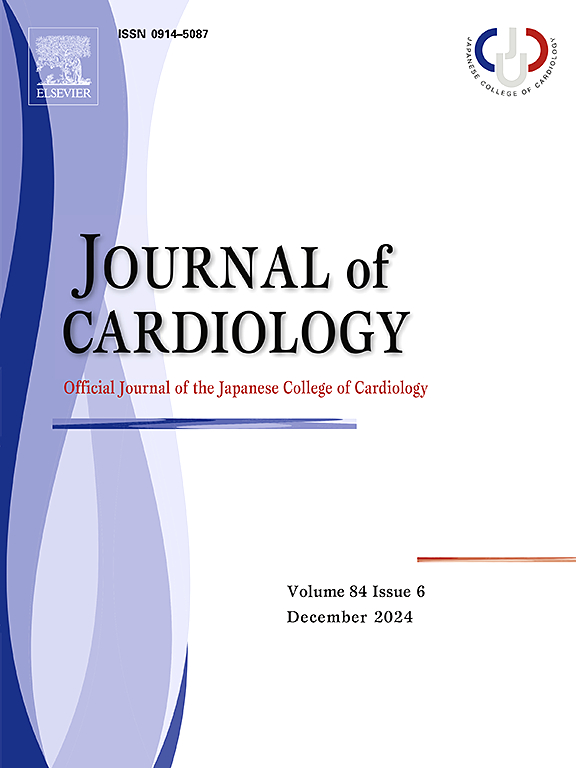经导管主动脉瓣置换术后透析患者死亡率风险模型。
IF 2.5
3区 医学
Q2 CARDIAC & CARDIOVASCULAR SYSTEMS
引用次数: 0
摘要
背景:与非透析患者相比,接受经导管主动脉瓣置换术(TAVR)的透析患者一般预后较差。此外,在这一临床环境中几乎没有可靠的风险模型。因此,我们旨在为接受经导管主动脉瓣置换术的透析患者建立一个风险模型,为他们的预后和经导管主动脉瓣置换术的决策过程提供信息:方法:2012 年至 2022 年间,我院共有 118 名患有严重主动脉瓣狭窄的透析患者(全队列)接受了 TAVR。全队列患者按 2:1 的比例随机分配到两组,组成衍生队列和验证队列。根据术前变量分析导致死亡的风险因素,并根据Cox比例危险模型建立风险模型:结果:在观察期间(811 ± 719 天),共有 69 例 TAVR 术后死亡病例,分别死于感染性疾病(43.5%)、心血管相关疾病(11.6%)、脑卒中或出血(2.9%)、癌症(1.4%)、不明原因(18.8%)和其他(21.7%)。采用卡普兰-梅耶法计算的全组 1 年、3 年和 5 年累积总生存率分别为 82.8%、41.9% 和 24.2%。由外周血管疾病、血清白蛋白、左心室射血分数等五项因素组成的最佳风险模型 结论:该风险模型能很好地反映患者的存活率:风险模型是估计接受TAVR的透析患者预后的良好指标。本文章由计算机程序翻译,如有差异,请以英文原文为准。

A risk model of mortality rate in dialysis patients following transcatheter aortic valve replacement
Background
Dialysis patients undergoing transcatheter aortic valve replacement (TAVR) generally have poor prognosis compared with non-dialysis patients. Furthermore, there are few reliable risk models in this clinical setting. Therefore, we aimed to establish a risk model in dialysis patients undergoing TAVR that would be informative for their prognosis and the decision-making process of TAVR.
Methods
A total 118 dialysis patients (full cohort) with severe aortic stenosis underwent TAVR in our institute between 2012 and 2022. The patients of the full cohort were randomly assigned to two groups in a 2:1 ratio to form derivation and validation cohorts. Risk factors contributing to deaths were analyzed from the preoperative variables and a risk model was established from Cox proportional hazard model.
Results
There were 69 deaths following TAVR derived from infectious disease (43.5 %), cardiovascular-related disease (11.6 %), cerebral stroke or hemorrhage (2.9 %), cancer (1.4 %), unknown origin (18.8 %), and others (21.7 %) during the observational period (811 ± 719 days). The cumulative overall survival rates using the Kaplan-Meier method at 1 year, 3 years, and 5 years in the full cohort were 82.8 %, 41.9 %, and 24.2 %, respectively. An optimal risk model composed of five contributors: peripheral vascular disease, serum albumin, left ventricular ejection fraction < 40 %, operative age, and hemoglobin level, was established. The estimated C index for the developed models were 0.748 (95 % CI: 0.672–0.824) in derivation cohort and 0.705 (95 % CI: 0.578–0.832) in validation cohort. The prediction model showed good calibration [intraclass correlation coefficient = 0.937 (95%CI: 0.806–0.981)] between actual and predicted survival.
Conclusions
The risk model was a good indicator to estimate the prognosis in dialysis patients undergoing TAVR.
求助全文
通过发布文献求助,成功后即可免费获取论文全文。
去求助
来源期刊

Journal of cardiology
CARDIAC & CARDIOVASCULAR SYSTEMS-
CiteScore
4.90
自引率
8.00%
发文量
202
审稿时长
29 days
期刊介绍:
The official journal of the Japanese College of Cardiology is an international, English language, peer-reviewed journal publishing the latest findings in cardiovascular medicine. Journal of Cardiology (JC) aims to publish the highest-quality material covering original basic and clinical research on all aspects of cardiovascular disease. Topics covered include ischemic heart disease, cardiomyopathy, valvular heart disease, vascular disease, hypertension, arrhythmia, congenital heart disease, pharmacological and non-pharmacological treatment, new diagnostic techniques, and cardiovascular imaging. JC also publishes a selection of review articles, clinical trials, short communications, and important messages and letters to the editor.
 求助内容:
求助内容: 应助结果提醒方式:
应助结果提醒方式:


